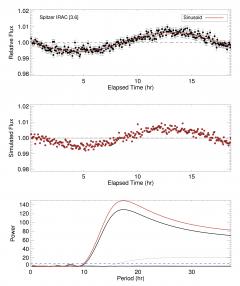Monitoring Weather Patterns with the Spitzer Space Telescope
In a recent paper we searched for evidence of weather patterns in the atmospheres of three free-floating ‘exoplanet analogues’ using the Spitzer Space Telescope.
In a recent paper we searched for evidence of weather patterns in the atmospheres of three free-floating ‘exoplanet analogues’ using the Spitzer Space Telescope. These objects form like stars, via the collapse of a molecular cloud but do not gain sufficient mass to sustain hydrogen burning in their cores. They are born hot and spend their lives cooling and dimming. The exoplanet analogues have masses, radii and temperatures that are similar to the population of directly-imaged planets, but are much easier to observe in the absence of a bright host star.

The exoplanet analogues typically have temperatures < 2000 K. At these temperatures, clouds of molten iron and magnesium silicates form in their atmospheres. In a technique known as variability monitoring, we can measure the brightness of an exoplanet analogue as it rotates. In this way we can search for evidence of these condensate clouds as they rotate in and out of view.
The three objects 2M2244, W0047 and SDSS1110 are members of the 120 million year old AB Doradus moving group. This means that these three objects formed in coeval, cospatial and comoving molecular clouds but have spatially dispersed over time.
W0047 and 2M2244 have remarkably similar spectra and colours. Spitzer variability monitoring revealed that they are both highly-variable objects (e.g. W0047 shown in the figure on the right). These low-gravity objects have high variability amplitudes compared to the well studied population of more massive brown dwarfs. The Spitzer light curves of W0047 and 2M2244 allow us to measure the rotational period of each object, finding periods of 11 h and 16 h for 2M2244 and W0047 respectively, comparable to rotational periods of planets in our own Solar System. We use high-resolution spectra to calculate their rotational velocities, or vsini, which allow us to calculate the viewing angle of each object. Both objects have remarkably similar inclination angles. Their colours and spectra are almost identical, so this is consistent with the idea proposed by Vos et al. 2017a that the viewing angle affects the observed atmospheric appearance.
In contrast to W0047 and 2M2244, the cooler (950 K) planetary-mass object SDSS1110 does not display significant variability, suggesting that the condensate clouds have gravitationally settled below the photosphere at these low temperatures.
Link: Variability of the Lowest Mass Objects in the AB Doradus Moving Group

